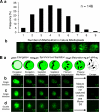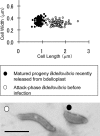Shadowing the actions of a predator: backlit fluorescent microscopy reveals synchronous nonbinary septation of predatory Bdellovibrio inside prey and exit through discrete bdelloplast pores
- PMID: 20935099
- PMCID: PMC3008530
- DOI: 10.1128/JB.00914-10
Shadowing the actions of a predator: backlit fluorescent microscopy reveals synchronous nonbinary septation of predatory Bdellovibrio inside prey and exit through discrete bdelloplast pores
Abstract
The Bdellovibrio are miniature "living antibiotic" predatory bacteria which invade, reseal, and digest other larger Gram-negative bacteria, including pathogens. Nutrients for the replication of Bdellovibrio bacteria come entirely from the digestion of the single invaded bacterium, now called a bdelloplast, which is bound by the original prey outer membrane. Bdellovibrio bacteria are efficient digesters of prey cells, yielding on average 4 to 6 progeny from digestion of a single prey cell of a genome size similar to that of the Bdellovibrio cell itself. The developmental intrabacterial cycle of Bdellovibrio is largely unknown and has never been visualized "live." Using the latest motorized xy stage with a very defined z-axis control and engineered periplasmically fluorescent prey allows, for the first time, accurate return and visualization without prey bleaching of developing Bdellovibrio cells using solely the inner resources of a prey cell over several hours. We show that Bdellovibrio bacteria do not follow the familiar pattern of bacterial cell division by binary fission. Instead, they septate synchronously to produce both odd and even numbers of progeny, even when two separate Bdellovibrio cells have invaded and develop within a single prey bacterium, producing two different amounts of progeny. Evolution of this novel septation pattern, allowing odd progeny yields, allows optimal use of the finite prey cell resources to produce maximal replicated, predatory bacteria. When replication is complete, Bdellovibrio cells exit the exhausted prey and are seen leaving via discrete pores rather than by breakdown of the entire outer membrane of the prey.
Figures




Comment in
-
Sighting the alien within: a new look at Bdellovibrio.J Bacteriol. 2010 Dec;192(24):6327-8. doi: 10.1128/JB.01174-10. Epub 2010 Oct 15. J Bacteriol. 2010. PMID: 20952572 Free PMC article. No abstract available.
References
-
- Barel, G., and E. Jurkevitch. 2001. Analysis of phenotypic diversity among host-independent mutants of Bdellovibrio bacteriovorus 109J. Arch. Microbiol. 176:211-216. - PubMed
Publication types
MeSH terms
Substances
Grants and funding
LinkOut - more resources
Full Text Sources

